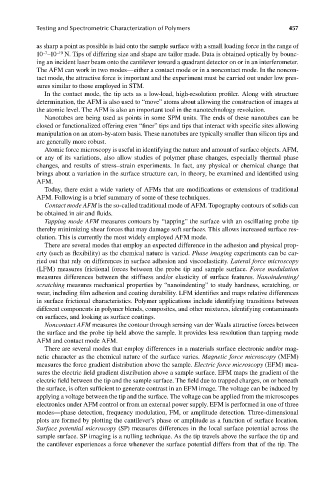Page 494 - Carrahers_Polymer_Chemistry,_Eighth_Edition
P. 494
Testing and Spectrometric Characterization of Polymers 457
as sharp a point as possible is laid onto the sample surface with a small loading force in the range of
–10
–7
10 –10 N. Tips of differing size and shape are tailor made. Data is obtained optically by bounc-
ing an incident laser beam onto the cantilever toward a quadrant detector on or in an interferometer.
The AFM can work in two modes—either a contact mode or in a noncontact mode. In the noncon-
tact mode, the attractive force is important and the experiment must be carried out under low pres-
sures similar to those employed in STM.
In the contact mode, the tip acts as a low-load, high-resolution profiler. Along with structure
determination, the AFM is also used to “move” atoms about allowing the construction of images at
the atomic level. The AFM is also an important tool in the nanotechnology revolution.
Nanotubes are being used as points in some SPM units. The ends of these nanotubes can be
closed or functionalized offering even “finer” tips and tips that interact with specific sites allowing
manipulation on an atom-by-atom basis. These nanotubes are typically smaller than silicon tips and
are generally more robust.
Atomic force microscopy is useful in identifying the nature and amount of surface objects. AFM,
or any of its variations, also allow studies of polymer phase changes, especially thermal phase
changes, and results of stress–strain experiments. In fact, any physical or chemical change that
brings about a variation in the surface structure can, in theory, be examined and identifi ed using
AFM.
Today, there exist a wide variety of AFMs that are modifications or extensions of traditional
AFM. Following is a brief summary of some of these techniques.
Contact mode AFM is the so-called traditional mode of AFM. Topography contours of solids can
be obtained in air and fl uids.
Tapping mode AFM measures contours by “tapping” the surface with an oscillating probe tip
thereby minimizing shear forces that may damage soft surfaces. This allows increased surface res-
olution. This is currently the most widely employed AFM mode.
There are several modes that employ an expected difference in the adhesion and physical prop-
erty (such as flexibility) as the chemical nature is varied. Phase imaging experiments can be car-
ried out that rely on differences in surface adhesion and viscoelasticity. Lateral force microscopy
(LFM) measures frictional forces between the probe tip and sample surface. Force modulation
measures differences between the stiffness and/or elasticity of surface features. Nanoindenting/
scratching measures mechanical properties by “nanoindenting” to study hardness, scratching, or
wear, including film adhesion and coating durability. LFM identifies and maps relative differences
in surface frictional characteristics. Polymer applications include identifying transitions between
different components in polymer blends, composites, and other mixtures, identifying contaminants
on surfaces, and looking as surface coatings.
Noncontact AFM measures the contour through sensing van der Waals attractive forces between
the surface and the probe tip held above the sample. It provides less resolution than tapping mode
AFM and contact mode AFM.
There are several modes that employ differences in a materials surface electronic and/or mag-
netic character as the chemical nature of the surface varies. Magnetic force microscopy (MFM)
measures the force gradient distribution above the sample. Electric force microscopy (EFM) mea-
sures the electric fi eld gradient distribution above a sample surface. EFM maps the gradient of the
electric field between the tip and the sample surface. The field due to trapped charges, on or beneath
the surface, is often sufficient to generate contrast in an EFM image. The voltage can be induced by
applying a voltage between the tip and the surface. The voltage can be applied from the microscopes
electronics under AFM control or from an external power supply. EFM is performed in one of three
modes—phase detection, frequency modulation, FM, or amplitude detection. Three-dimensional
plots are formed by plotting the cantilever’s phase or amplitude as a function of surface location.
Surface potential microscopy (SP) measures differences in the local surface potential across the
sample surface. SP imaging is a nulling technique. As the tip travels above the surface the tip and
the cantilever experiences a force whenever the surface potential differs from that of the tip. The
9/14/2010 3:42:14 PM
K10478.indb 457 9/14/2010 3:42:14 PM
K10478.indb 457

